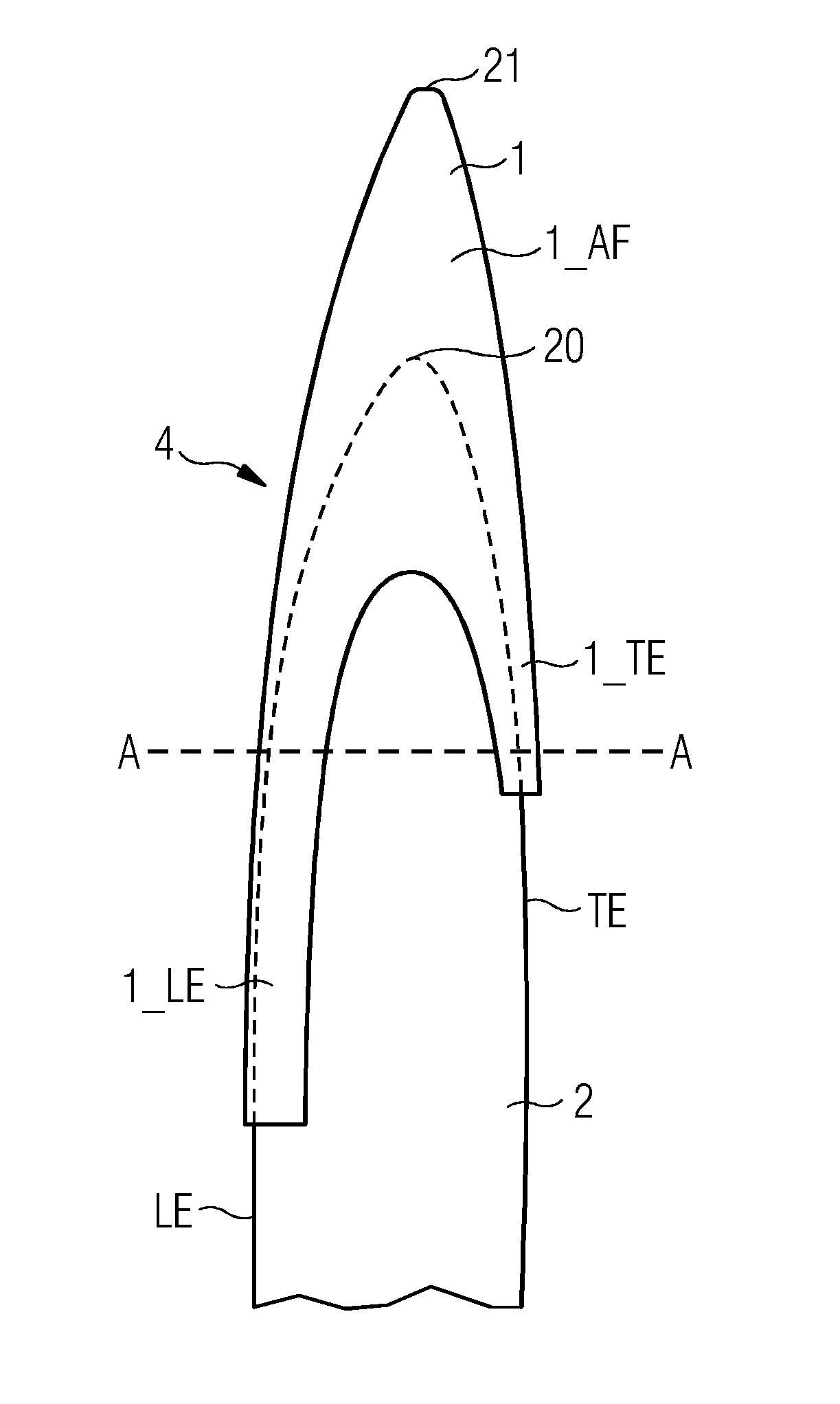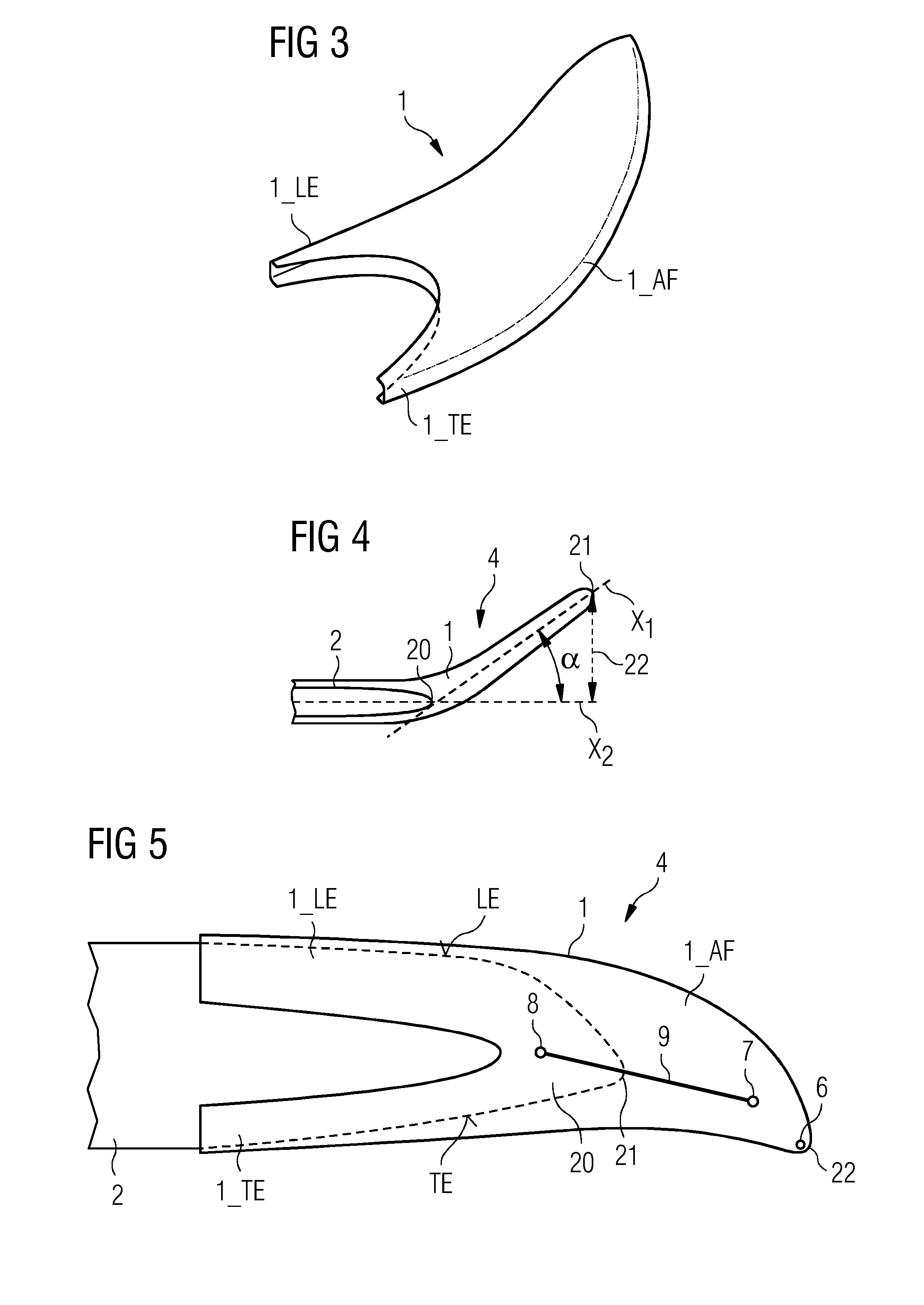Rotor blade extension
a technology of rotor blades and wind turbines, which is applied in the field of rotor blade extension and wind turbines, can solve the problems of reducing the annual energy production (aep) and an increase in the noise level of the turbine, the aerodynamic properties of the altered blade can significantly deviate from the original intended design, and the root extension is aerodynamically inefficient, so as to achieve constant, (or only negligible increase) the distance between the extended blade tip and the tower, the effect o
- Summary
- Abstract
- Description
- Claims
- Application Information
AI Technical Summary
Benefits of technology
Problems solved by technology
Method used
Image
Examples
first embodiment
[0045]FIG. 1 shows the outboard part of an extended rotor blade 4 of a wind turbine 3. The extended rotor blade 4 comprises a rotor blade extension 1 according to embodiments of the invention, which is in place over the tip 20 of the rotor blade 2. The rotor blade 2 comprises a trailing edge TE and a leading edge LE. The rotor blade 2 is tapered, i.e. pointed, and comprises a tip 20. Reference sign 20 refers to the tip of the “original” rotor blade 2, i.e. the rotor blade 2 without any rotor blade extension. Once the rotor blade extension 1 is attached to the rotor blade 2, the extended rotor blade 4 is obtained. Reference sign 21 refers to the tip of the extended rotor blade 4, thus, it is also referred to as the “extended tip”21.
[0046]The rotor blade extension 1 is shown to comprise an airfoil extension portion 1_AF that effectively extends the length of the rotor blade 2; a leading edge portion 1_LE that is used to cover or extend a portion of the leading edge LE of the rotor bla...
second embodiment
[0048]FIG. 3 shows a rotor blade extension 1 according to embodiments of the invention. Here, the rotor blade extension 1 exhibits a significant degree of pre-bend, i.e. the airfoil portion 1_AF is bent outwards so that, when mounted onto a rotor blade, the airfoil portion 1_AF will face “into the wind”.
[0049]The extent of the pre-bend is shown in cross-section in FIG. 4, which shows a longitudinal axis X2 of the rotor blade 2 and a longitudinal axis X1 extending through the airfoil portion 1_AF of the rotor blade extension 1.
[0050]A first approach to characterize and quantify the extent of the pre-bend of the rotor blade extension 1 is an angle α subtended by these axes X2, X1.
[0051]A second approach to characterize and quantify the extent of the pre-bend of the rotor blade extension 1 is the distance 22 between the extended tip 21 and the longitudinal axis X2. This distance 22 relates to the amount by which the distance between the tip of the rotor blade and the tower of the wind ...
third embodiment
[0054]FIG. 5 shows a rotor blade extension 1 according to embodiments of the invention. In this example, the portions 1_LE, 1_TE have essentially the same length. The rotor blade 2 comprises a swept-back tip, i.e. the tip of the blade is angled more towards the trailing edge TE than towards the leading edge LE. In this embodiment, the airfoil portion 1_AF is also “swept back”, so that the sweep of the original blade design is repeated or even increased by the sweep of the rotor blade extension 1. This embodiment can be combined with the embodiment of FIG. 4, for example, to give a rotor blade extension 1 that exhibits sweep as well as pre-bend.
[0055]The rotor blade extension 1 of FIG. 5 also comprises a drainage hole 6 for enabling liquid, such as water, to exit the inside of the extended rotor blade 4. Furthermore, the rotor blade extension 1 comprises an extension lightning receptor 7 for attracting lightning strikes, which typically strike a rotor blade in the proximity of the ti...
PUM
 Login to View More
Login to View More Abstract
Description
Claims
Application Information
 Login to View More
Login to View More - R&D
- Intellectual Property
- Life Sciences
- Materials
- Tech Scout
- Unparalleled Data Quality
- Higher Quality Content
- 60% Fewer Hallucinations
Browse by: Latest US Patents, China's latest patents, Technical Efficacy Thesaurus, Application Domain, Technology Topic, Popular Technical Reports.
© 2025 PatSnap. All rights reserved.Legal|Privacy policy|Modern Slavery Act Transparency Statement|Sitemap|About US| Contact US: help@patsnap.com



